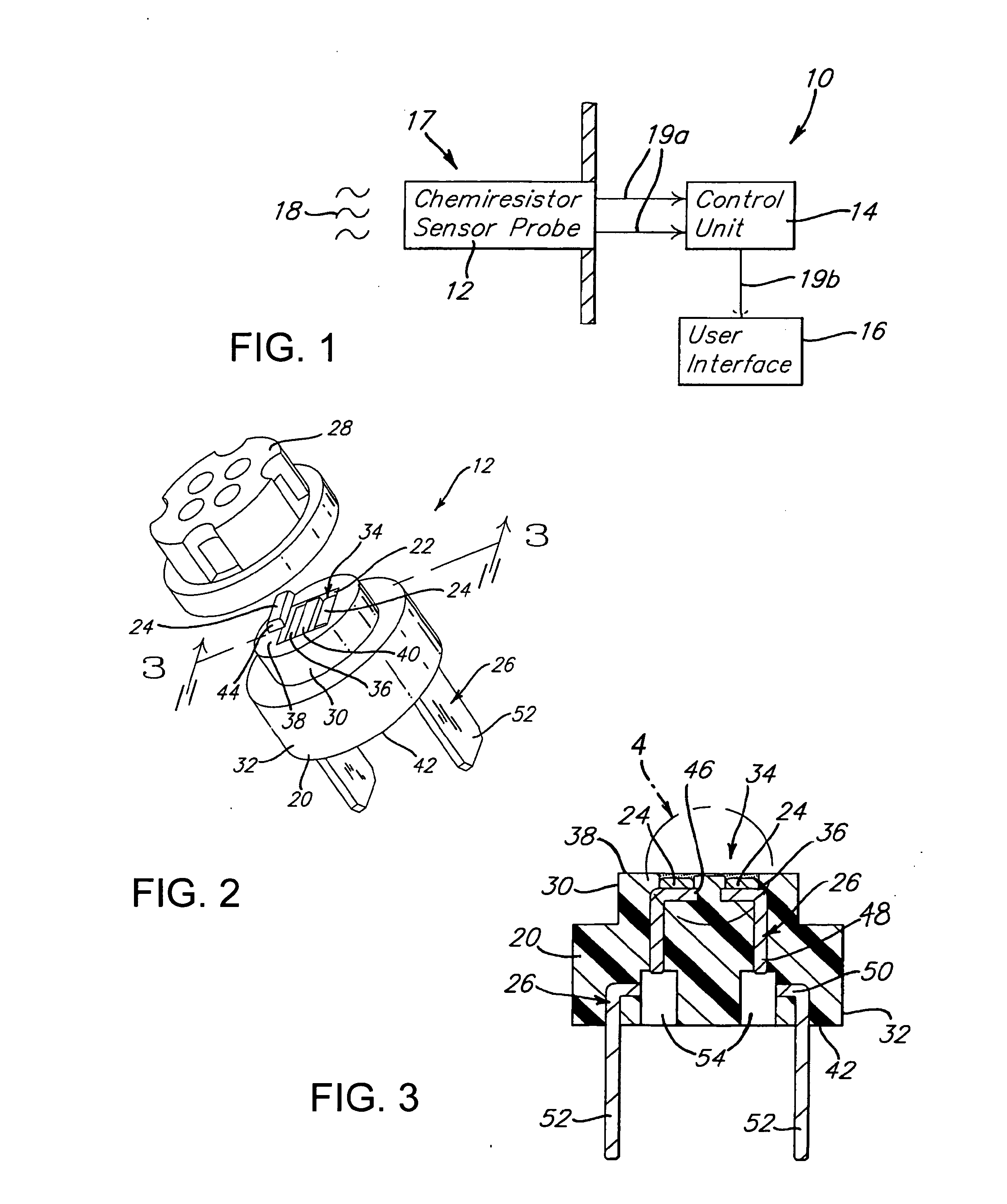Robust Low Resistance Vapor Sensor Materials
a technology of vapor sensor and low resistance, applied in the field of sensor films, can solve the problems of low resistance sensor and film volatilization chang
- Summary
- Abstract
- Description
- Claims
- Application Information
AI Technical Summary
Benefits of technology
Problems solved by technology
Method used
Image
Examples
example 1
[0060]A sensor film polymer matrix having a blend of conductive particles including a multi-walled carbon nanotube (MWNT) and a large particle size conductive carbon black is prepared by adding the following materials: 15.4 grams of a 3-5% vinylmethylsiloxane-35-40% octylmethylsiloxane-20-60% dimethylsiloxane terpolymer (commercially available as VAT 4326 from Gelest, Inc. of Tullytown, Pa.) which is a large hydrocarbon side group substituted siloxane polymer; 8.2 grams of a 7-13% hydromethylsiloxane-87-93% octylmethylsiloxane copolymer; 2.8 grams of multi-walled nanotubes having dimensions of 60-100 nm (outer diameter)×5-10 nm (wall thickness)×0.5-50 μm (length) available from from Aldrich; 18.2 grams of Asahi 15HS (a large particle size carbon black available from Asahi Carbon Company having an N2 value of 14 m2 / g and a DBP of 85 ml / 100 g); 0.09 grams of a platinum carbonyl cyclovinylmethylsiloxane catalyst complex (commercially available as SIP 6829 from Gelest, Inc.). The nanotu...
example 2
[0061]Example 2 is prepared in a similar manner to Example 1, however the sensor film matrix has a lower concentration of multi-walled carbon nanotube particles. The following materials are added: 15.6 grams of a 3-5% vinylmethylsiloxane-35-40% octylmethylsiloxane-20-60% dimethylsiloxane terpolymer (commercially available as VAT 4326 from Gelest, Inc. of Tullytown, Pa.) which is a large hydrocarbon side group substituted siloxane polymer; 9.27 grams of a 7-13% hydromethylsiloxane-87-93% octylmethylsiloxane copolymer; 0.9 grams of multi-walled nanotubes having dimensions of 60-100 nm (outer diameter)×5-10 nm (wall thickness)×0.5-50 μm (length) available from Aldrich; 13.96 grams of Asahi 15HS (a large particle size carbon black available from Asahi Carbon Company having an N2 value of 14 m2 / g and a DBP of 85 ml / 100 g); 0.1 grams of a platinum carbonyl cyclovinylmethylsiloxane catalyst complex (commercially available as SIP 6829 from Gelest, Inc.). The nanotubes and carbon black parti...
example 3
[0062]Example 3 is prepared in a similar manner to Examples 1 and 2, however with another blend of carbon nanotubes and carbon black particles. The following materials are added: 15.5 grams of a 3-5% vinylmethylsiloxane-35-40% octylmethylsiloxane-20-60% dimethylsiloxane terpolymer (commercially available as VAT 4326 from Gelest, Inc. of Tullytown, Pa.) which is a large hydrocarbon side group substituted siloxane polymer; 9.21 grams of a 7-13% hydromethylsiloxane-87-93% octylmethylsiloxane copolymer 1.25 grams of multi-walled nanotubes having dimensions of 60-100 nm (outer diameter)×5-10 nm (wall thickness)×0.5-50 μm (length) available from Aldrich; 13.85 grams of Asahi 15HS (a large particle size carbon black available from Asahi Carbon Company having an N2 value of 14 m2 / g and a DBP of 85 ml / 100 g); 0.1 grams of a platinum carbonyl cyclovinylmethylsiloxane catalyst complex (commercially available as SIP 6829 from Gelest, Inc.). The nanotubes and carbon particles are pre-mixed toget...
PUM
 Login to View More
Login to View More Abstract
Description
Claims
Application Information
 Login to View More
Login to View More - R&D
- Intellectual Property
- Life Sciences
- Materials
- Tech Scout
- Unparalleled Data Quality
- Higher Quality Content
- 60% Fewer Hallucinations
Browse by: Latest US Patents, China's latest patents, Technical Efficacy Thesaurus, Application Domain, Technology Topic, Popular Technical Reports.
© 2025 PatSnap. All rights reserved.Legal|Privacy policy|Modern Slavery Act Transparency Statement|Sitemap|About US| Contact US: help@patsnap.com


